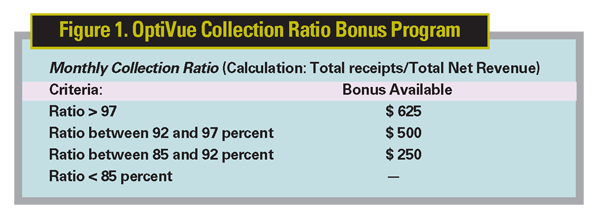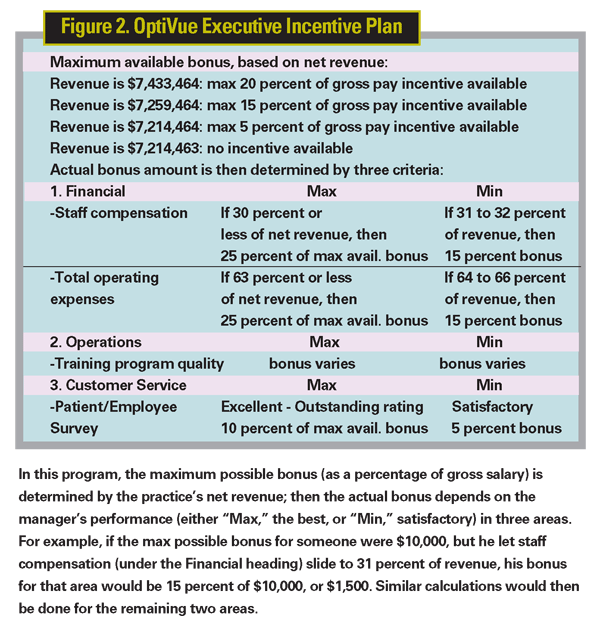Dwight Eisenhower once said, "Motivation is the art of getting people to do what you want them to do because they want to do it." One of the best ways to get someone to do something is to offer a reward. An accounts receivable clerk isn't very personally invested in keeping the percentage of your A/R aged 90 days or more below 14 percent or so, because he gets his paycheck either way. Offer him a bonus for doing it, though, and you might be surprised how he responds. In this article, experts with decades of combined experience in managing staff and structuring bonus systems share their advice on how to institute an effective bonus program in your office.
General Considerations
Though bonuses can reap benefits for the entire practice, experts say they should be considered carefully. They don't work in all situations, or for all employees. Here are several things to take into account:
• Be sure you're operating efficiently first. Before you put a bonus system into place, Michael Brown, president of the consultant firm Health Care Economics in
"For example, if your practice data and/or research shows that a billing person should do 82 claim forms a day, for example, you have to bring him up to that level before you can start thinking about bonus incentives," says Mr. Brown.
• Know your employees. Candace Simerson, president and chief operating officer for Minnesota Eye Consultants in
• Avoid entitlements. Consultant Stephen Robinson, of Advantage Administration in
• Know the cost of bonuses. "Keep in mind that bonuses cost you a lot more than just handing over a $100 bill," explains Mr. Brown. "You have to pay taxes on them, such as payroll tax and employer's matching tax, so that $100 will cost you $150 with taxation. Then, you have to add benefits to the $100, which adds 25 percent. Basically, I tell my ophthalmic clients that every dollar they spend on bonuses costs them about two times that."
Setting Goals, Giving Bonuses
One of the keys to an effective bonus plan are the goals that you set for the employees. Consultants and managers have advice for setting goals properly.
"I always say that goals are things that are SMART: Specific; Measurable; Attainable; Realistic and have a Timetable attached to them. If they are these things, then you have something that's real and tangible for the staff, who can say, 'OK, I know what I've got to do and now I can make a plan to get there,' " Mr. Robinson says. He also says the goals should tie in to the success of the practice itself, rather than be too specific to the individual. An example of a proper goal would be for an accounts receivable manager to keep the number of receivables 90 days or older under 14 percent. This relates both to the individual's performance and to the practice's.
Mrs. Simerson says it's best if the goals are "stretch objectives." "You want the employee to have to reach a little to achieve them, but you don't want the goals to be so unattainable that he or she doesn't even bother to try," she says.
Experts say setting the goals involves both knowledge of benchmarks for practices such as yours, as well as an understanding of what your own practice is capable of based on past performance.
"We have 300 active ophthalmology clients," says Mr. Brown. "So we have a lot of data to draw on. I also read a lot of the industry magazines and glean benchmark ideas from their articles. More important, however, is the data we get from the particular group we're working with, because two groups only a block apart could be different. The bonus program might differ based on such factors as how many full-time equivalent employees you have, how money-motivated you are, or how far you'll let employees go when attempting to collect money. Each practice is actually benchmarked based on its own performance."
The type of practice also has an impact. Mrs. Simerson offers her own practice as an example. "Because all of our surgeons are subspecialists, we do a lot more testing. As such, we may not be able to hit the same patient-per-hour benchmark as another practice because we're doing more ancillary tests. However, we'll be generating more revenue for each patient because of the extra testing."
Following are some ideas for how a bonus program might work for different job descriptions.
• Accounts receivable staff. Like optical, this area of the practice seems to lend itself to bonus incentivizing, since it has measurable goals.
Mary Martin, president and chief executive officer at OptiVue, a five-office practice in
The third goal is team efficiency in posting patients' explanation of benefits forms. If they're posted in an average of three days or fewer, it's worth $125. The final benchmark is "softer," and involves attending a business seminar, then returning to teach the A/R staff what was learned. If both manager and staff can demonstrate their knowledge, it's worth $125.

• Optical employees. Mr. Brown says an optical is conducive to incentives. "I prefer to do the bonus as a split of net profits after everything is paid and the revenue is in the books," he explains. "Then, I determine a percentage of that to share with the optical staff. For instance, if we're making $10,000 per month and go up to $11,000, then I'll give them half of that excess amount above baseline, or $500 to split equally."
• Ophthalmic techs. Since a tech's job is harder to quantify than an optical salesperson's, it can be more challenging to nail down a bonus plan for them. Mr. Brown suggests basing it on goals for the back office, such as increasing the number of patients who come through the door, better time management or increased testing. Mrs. Simerson says her practice is considering starting bonuses for decreasing the percentage of patients with missed charges on their files, with an aim to keep it under 5 percent.
"Also, for the back-office staff, the bonus may not necessarily be cash, but could be something like a day at a spa or a free dinner," notes Mr. Brown. "This is because, in the back, it's hard to define cash bonuses effectively based on their goals."
• Executive staff. Mrs. Martin says her executive staff is also eligible for its own bonus plan. The executive staff consists of such employees as the controller, the chief operating officer, the CEO, and the scheduling supervisor. In another practice, it could be tailored for any managerial staff.
The maximum bonus available to the executive is determined by the net revenue of the practice on a graduated scale, and the bonus can be as much as 20 percent of the individual's gross pay. For example, if net revenue is $7,214,463 or less, there is no bonus, if it's $7,433,464 or above, the available bonus would be the full 20 percent of gross pay. The amount the employee actually receives, up to that available bonus limit, depends on three areas of evaluation. (See Figure 2, below.)
The first area, which can make up half of the total bonus received, is financial, and indicates how well the executives controlled staff compensation (not counting MD and OD compensation) and total operating expenses in the past year. In this area, if employee compensation is no more than 30 percent of net revenue, then the executive will receive 25 percent of his max available bonus, for example.
The second area executives are graded on is operations, which mainly entails how effective any employee training programs they've instituted have been. At OptiVue, each executive is responsible for one training program per month, such as a review of new CPT codes, followed by a quiz. Mrs. Martin says they're still experimenting with this grading area and tying it to a monetary bonus, though it can be worth up to 40 percent of the max bonus if an executive's monthly programs have been very effective. 
The final area used for calculation of the executive bonus is customer service, which bases a bonus of up to 10 percent of the max available on the results of surveys of patients and staff in the executive's department. Patient responses might entail how comfortable they were postop, for example. The staff survey is an anonymous, "360-degree" survey of subordinates that reviews the executive's interpersonal skills. If all surveys are positive, the executive can receive 10 percent of the max available bonus, but can receive as little as 5 percent if the surveys are less than stellar.
• LASIK coordinators. OptiVue also has a system in place for doling out bonuses to its LASIK manager and LASIK counselors. In it, the LASIK management staff is entitled to a 5.5-percent bonus on half the net LASIK revenue if it's over $100,000, or the revenue minus $50,000 if it's $100,000 or less, minus expenses. Of the bonus, the LASIK manager gets 3 percent, the next most experienced counselor receives 2 percent, followed by 0.25 percent for the third counselor and 0.25 percent for the fourth. So, if July's net LASIK revenue is $120,000, half of that, or $60,000, would be the basis for the bonuses. The LASIK staff members would then receive 5.5 percent of $60,000, or $3,300, to split among themselves.
Mr. Brown says, when done right, bonuses can be effective, but you always have to keep thinking about how you'll deal with it when the first level of goals is achieved, because you can't just take away a bonus program once it's begun without risking a drop in morale. "So, you have to keep setting new benchmarks," he says. "Once you've started it, you have to keep riding that horse—you can't get off at the rodeo."







